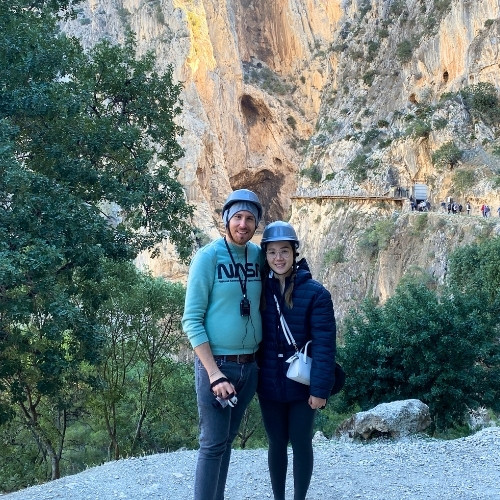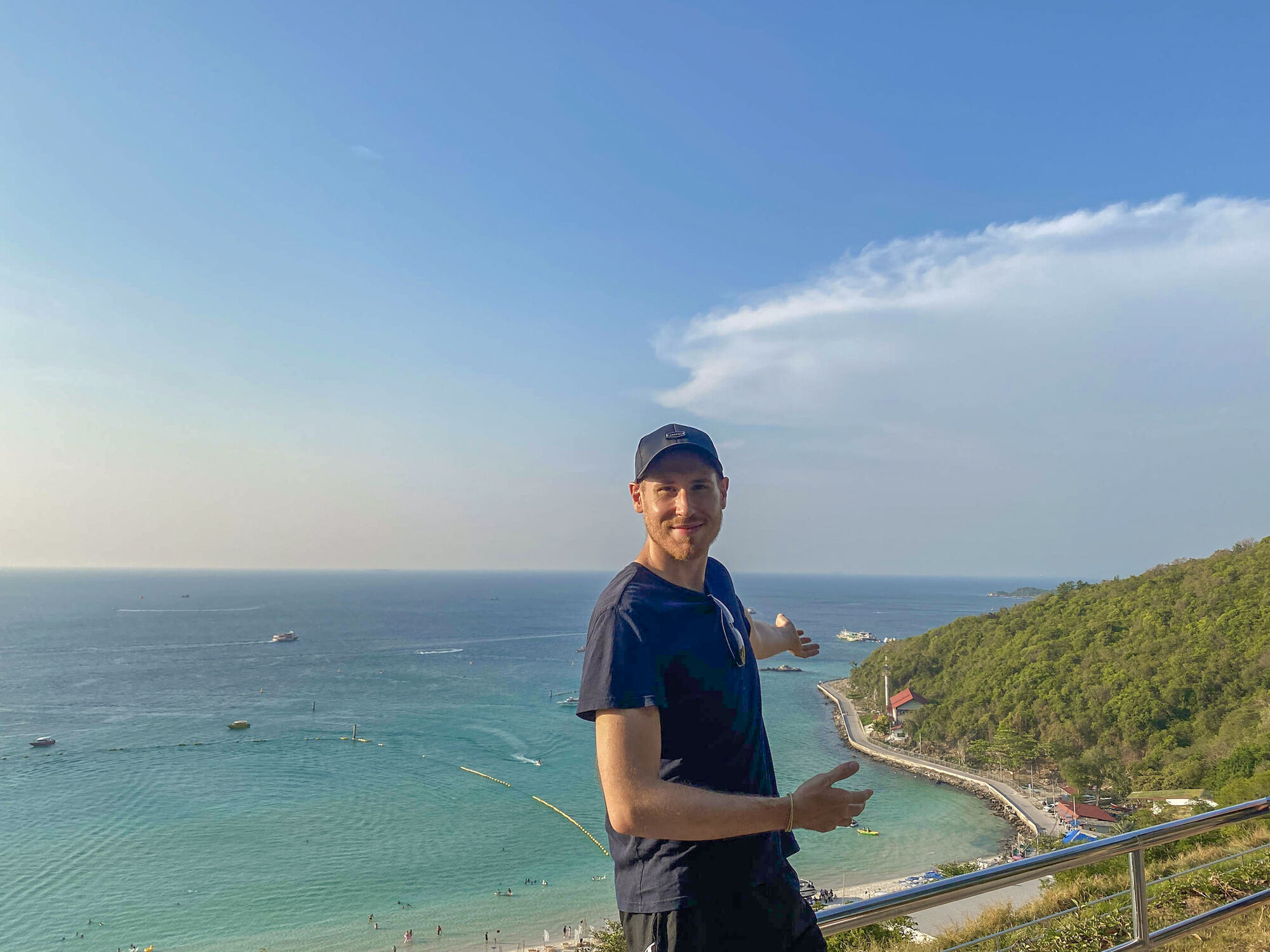Hello Seville! I’ve been here so many times in the past few years, and I’m not gonna lie, Seville is hard to beat. When I planned my trip, I just couldn’t decide on the things to do in Seville, and I’m glad you found this guide to help you out.
You find cool architecture, fiery flamenco beats, and some of Spain’s top tapas all around.
The city loves a good party. It’s a dream spot if you’re curious about the past. You soak up centuries of heritage while you walk along old paths that tell tales of mixed cultures.
That’s just a starter, because the tourist attractions in Seville are fun, super interesting, and you won’t get bored that’s for sure.
Want to know why it was such a good trip? Here’s the ultimate guide with all the tourist spots in Seville and some essentials you’ll need when visiting.
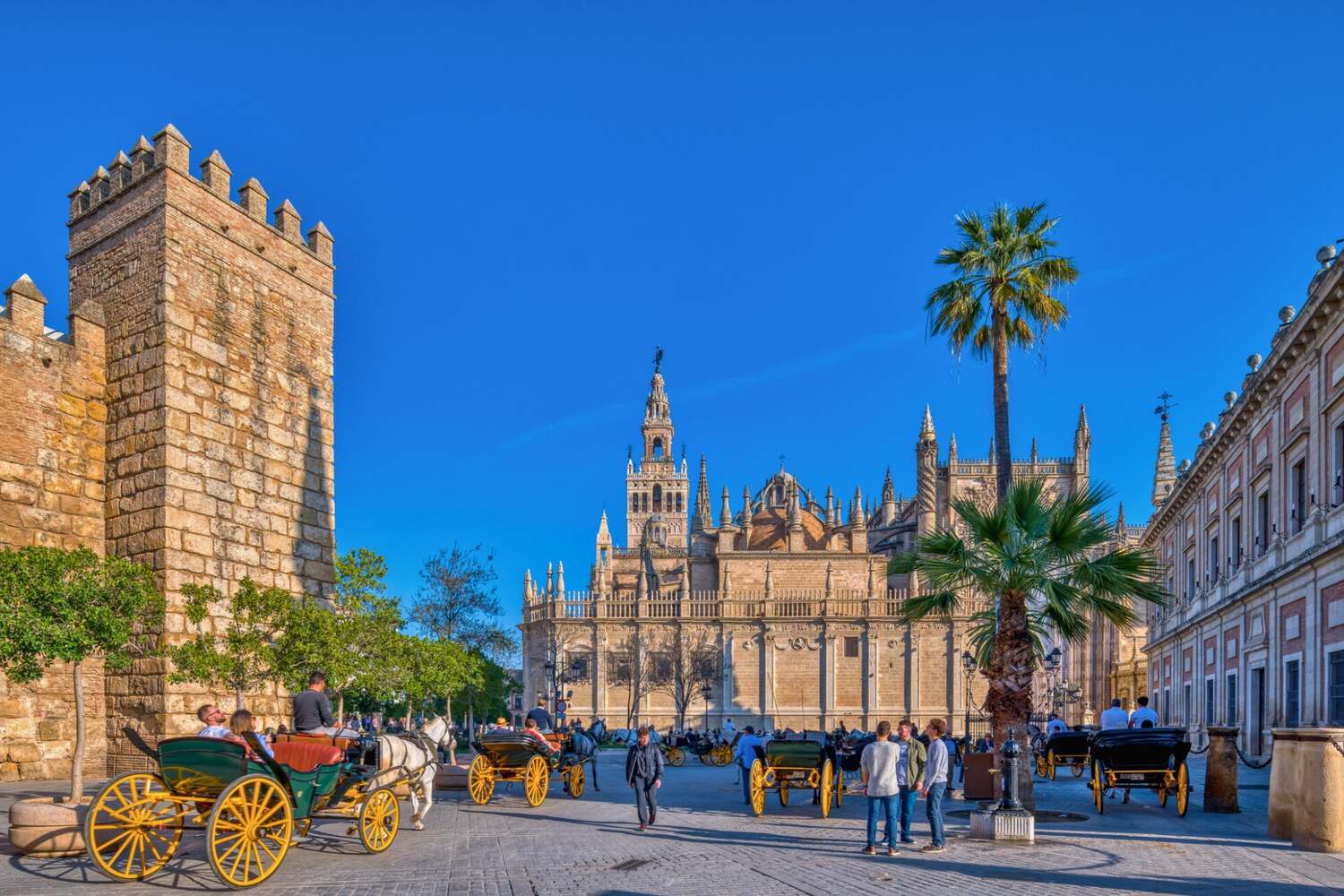
15 Best Things to Do in Seville
Let me start by saying this: In Seville, You’re in for a treat. This list below shows you must-see spots, lively areas, and secret nooks that pack each day with local flair and moments you won’t forget.
Most importantly before you go, I want to mention that many tourist attractions sell out early. I recommend booking everything ahead of time.
1. Visit the Real Alcázar of Seville
The Real Alcázar has roots way back in the 10th century when it was originally an Arab fort. Over the years, kings and rulers added their own touches, mixing Mudéjar, Gothic, Renaissance, and Baroque styles.
When you visit, you walk through halls with carved wooden ceilings, see rooms decked with mosaic tiles, and spend some time in gardens that are full of history. I love those gardens, so please check them out. It did remind me of La Alhambra in Granada a little bit.
The gardens have water features and old trees that make every step feel like a little peek into the past. Tickets cost €15.50 per person if you book online, and sometimes there’s an extra charge if you want a tour guide.
Every patio and chamber tells its own story. And yes, it will make you feel like you’re part of centuries of change… and that’s just the truth.
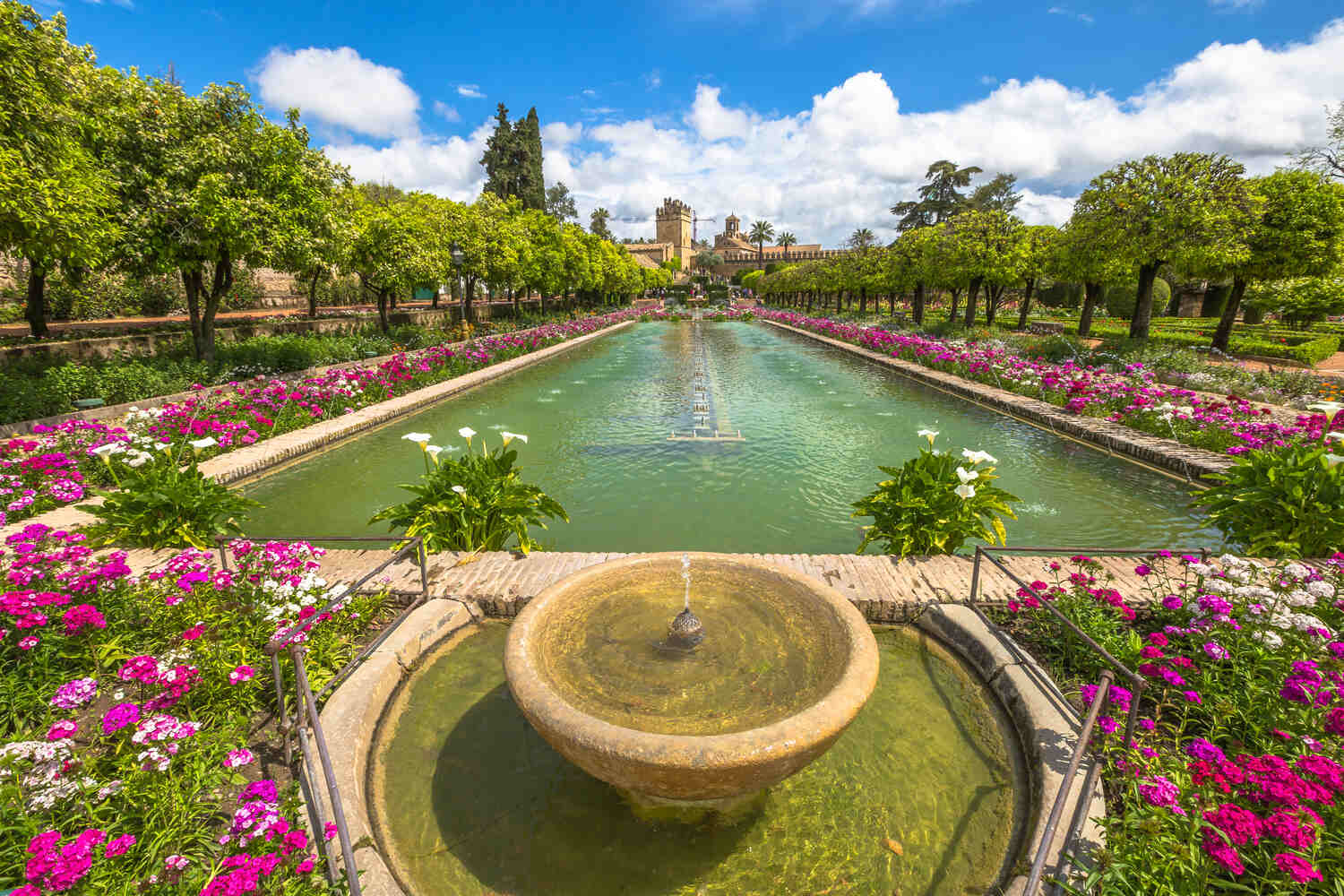
2. Explore Seville Cathedral and La Giralda
Next? Seville Cathedral. This cathedral is massive, probably the biggest Gothic church you’ve ever seen. Inside, you get hit with sky-high arches, gorgeous chapels, and even Columbus’s tomb.
The stained glass catches the sunlight in a nice way, lighting up the whole place. Right next to it, you can visit La Giralda bell tower.
It’s built with ramps (yes, for horses back in the day). When you climb them, you get an epic view of the city. Probably the best views in the city, so a special mention for this.
Pro tip: get here early or later in the day to avoid crazy lines and the worst of the heat. If you book online, some tours even let you check out the upper levels so you can really get into the details… and you can’t miss that.
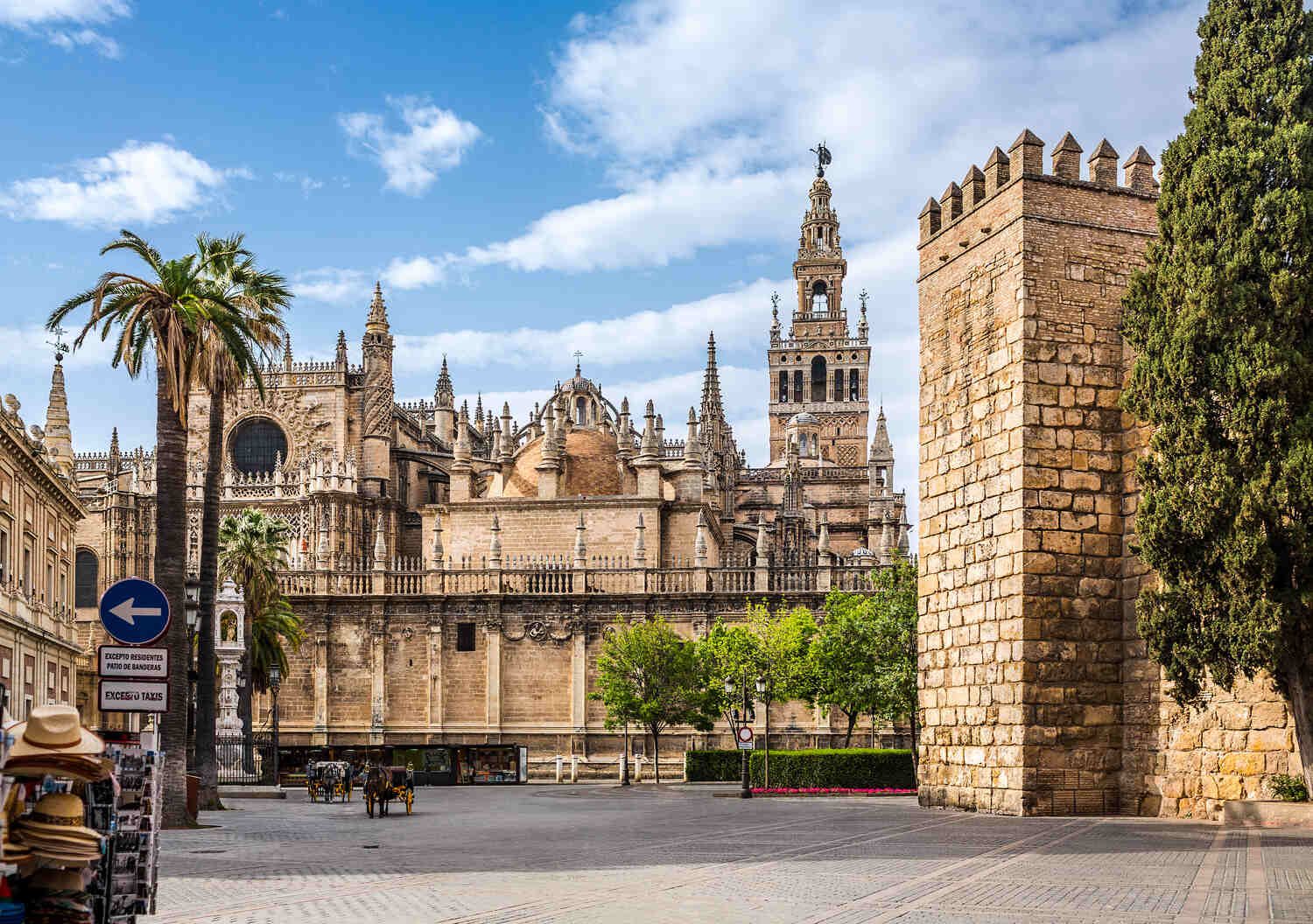
3. Walk Through the Barrio Santa Cruz
Barrio Santa Cruz is Seville’s old Jewish Quarter. And I want to say, it’s as laid-back as it gets, and we particularly like it.
You stroll along tiny stone lanes, pop into little squares where locals hang out, and see white houses all around. The area reminded me a little bit of Pueblos Blancos in southern Spain, which I highly recommend by the way.
We’re all about discovering places that show the real Andalucìa, and despite being a popular spot, this is one of them.
The air feels real warm and lived-in. This was probably my favorite area to walk around in Seville.
Stop by a small tapas spot (I suggest Bar Las Columnas, we loved it) and try some jamón ibérico or crunchy croquettes.
Later, chill out at Plaza de Santa Cruz under a bunch of orange trees. Oh, and don’t miss Callejón del Agua – It’s a tiny alley with water running along the old city walls.
You’ll see the old European feeling everywhere here, and a lot of people end up staying longer than they planned; No doubt about it. You can easily spend hours here, but a couple would be enough I reckon.
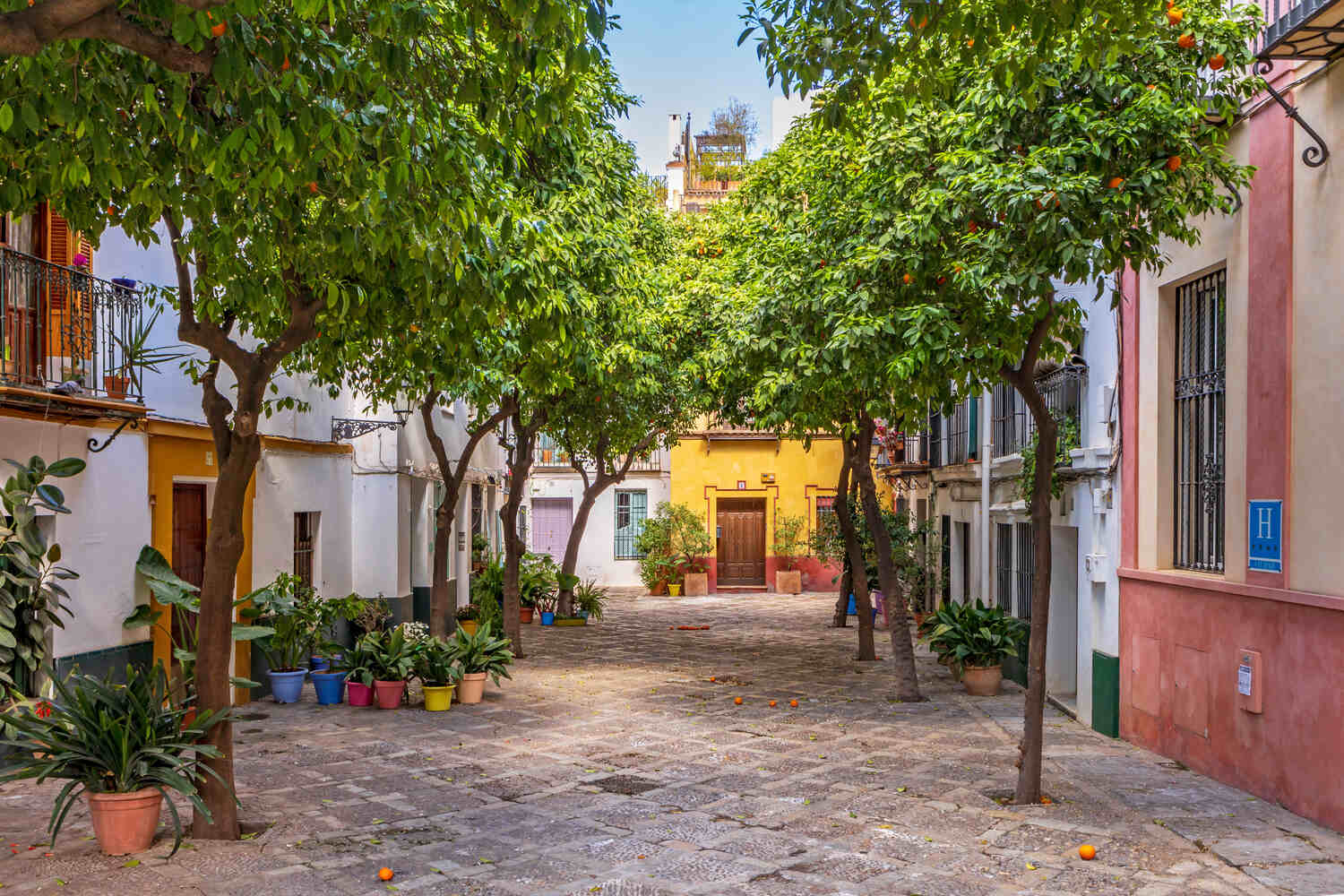
4. Watch a Flamenco Show in Triana
I did attend several flamenco shows throughout the years in Malaga and Granada, but I was so excited to see one in Seville! The origin of Flamenco is linked to both Granada and Seville. I did see a show in Granada, but never in Seville, so here’s what you can expect:
Triana is known to be the best place to see a Flamenco show in Seville. Home to singers and dancers who turned this passionate art form into a crazy performance.
You’ll find live shows nightly. Tablaos and venues, such as Teatro Flamenco Sevilla or bars along Calle Betis, have stunning shows. We started by grabbing the tickets online. I told you that tourist attractions do sell out, and this is definitely one of them – We booked like a week before.
Stand near the stage if you can. The performers’ stomping and singing feel electric up close! This is one of the most emotional moments we’ve had in Andalusia, and surely not in a bad way!
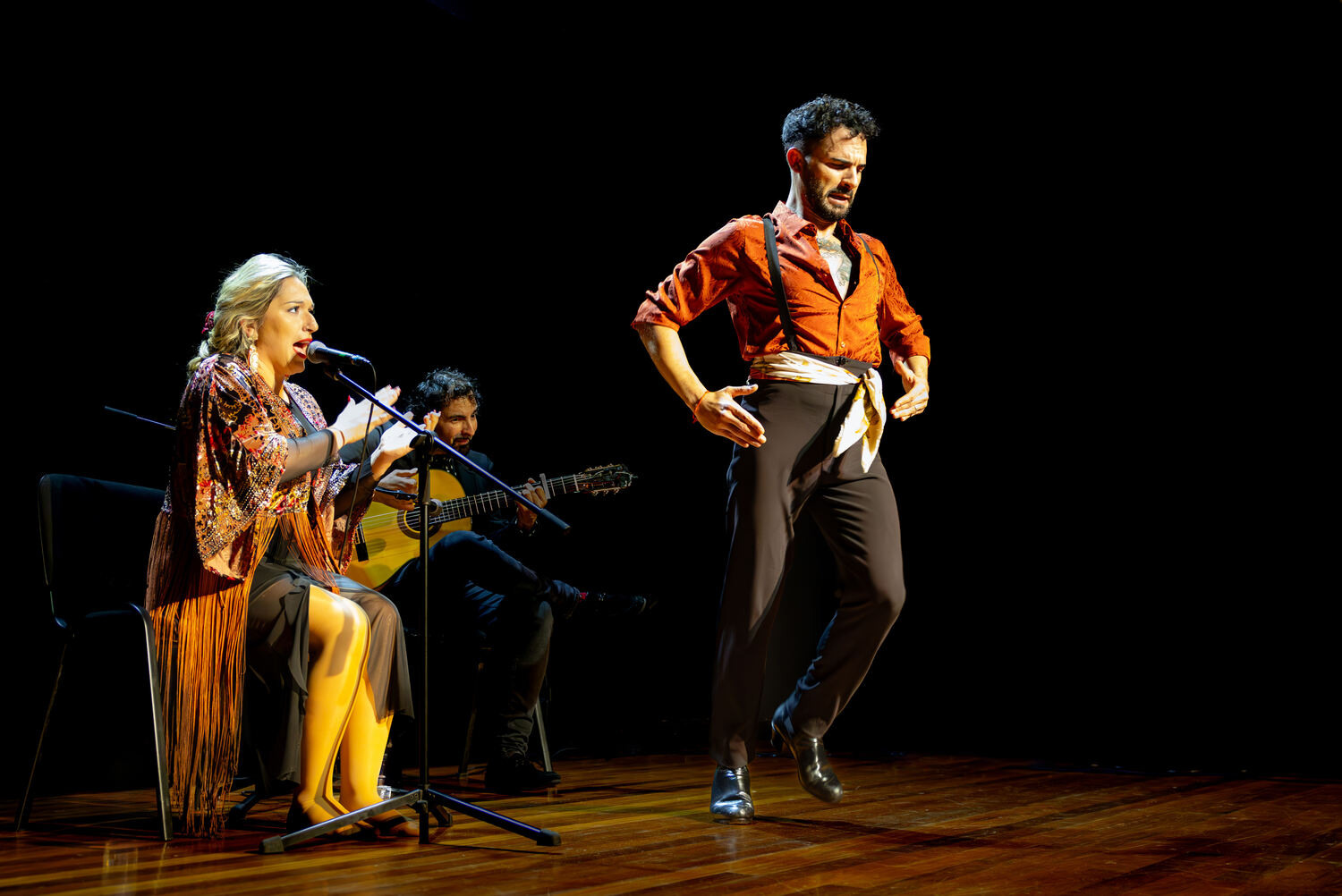
5. Stroll Through Plaza de España
Plaza de España is your “Oh my Goodness” moment. The plaza was built in 1928 for the 1929 Ibero-American Exposition.
Yes, it’s not the most ancient architecture in the city, but trust me when I say it’s worth visiting.
It has Neo-Mudéjar architecture with mosaics showing different regions of Spain, and an nice canal where you can row a small boat. The 35-minute ride costs 6 euros, which is very reasonable, and there’s a deposit of 4 euros.
The entrance to the Plaza de España is, on the other hand, free.
It’s stunning from every angle. There are colorful azulejos represent different Spanish provinces, and you’ll see people snapping pictures at each panel, which is kind of fun,
Mornings are usually less crowded. So make sure to come early if possible, maybe around 8 or 9 am?
You might also catch the warm glow on the tiled alcoves when the sun is low, which makes your photos pop even more. After that, around lunch time, there are many more people, no matter the season, so please set up your alarm early and enjoy your time (I’m sure you will!).
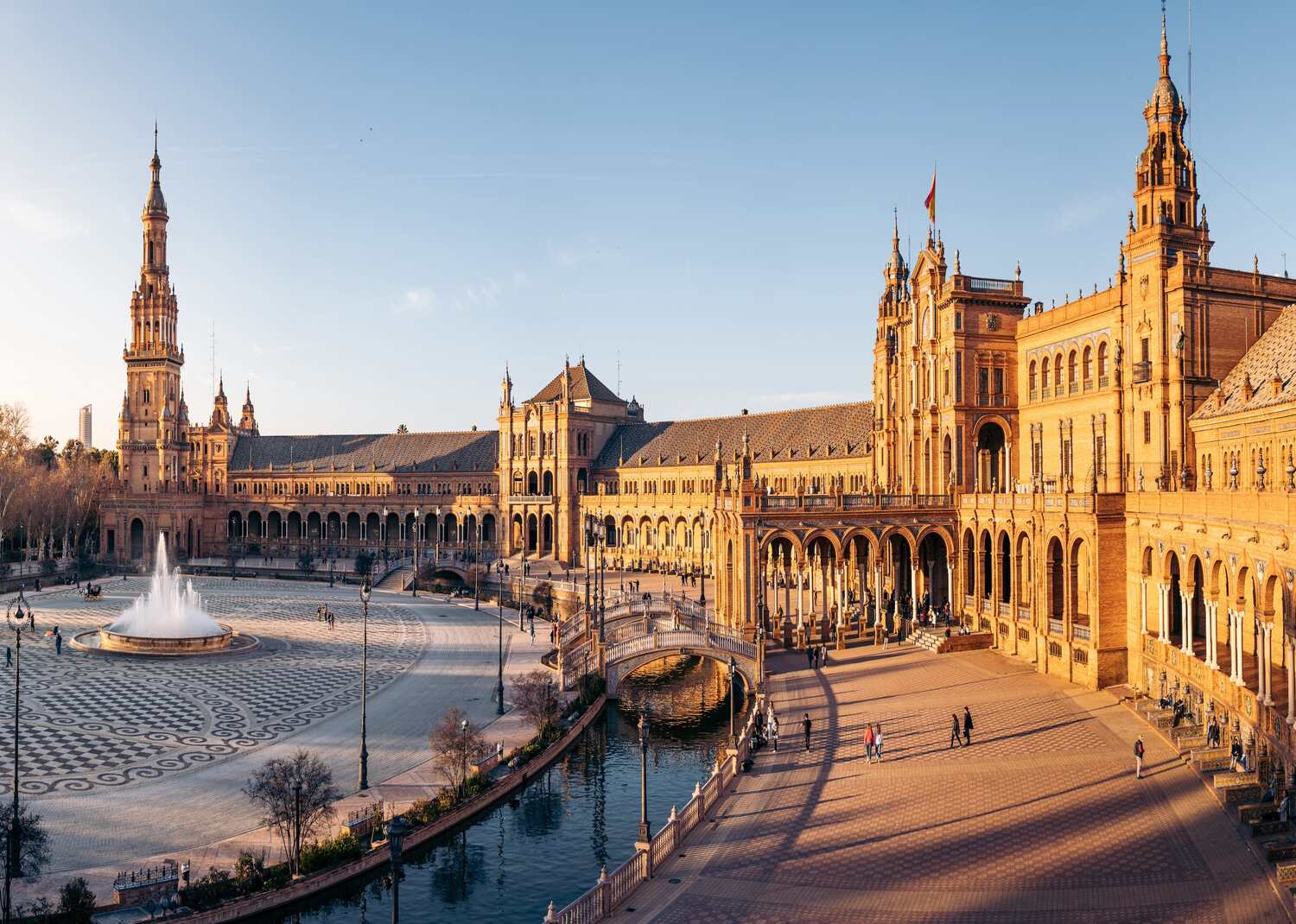
6. Enjoy Tapas and Andalusian Cuisine
Seville’s food scene is mouthwatering. Yes, I know what you think: This is the case for all of Andalucìa.
You’ll find Andalusian staples like gazpacho, salmorejo, and fried fish, all served in lively bars where bartenders shout orders and plates arrive quickly. That’s what I love about this part of Spain!
The key is to order small portions to try as much as possible. Note that tapas-hopping is a thing here, so pop into El Rinconcillo, the oldest tavern around, or explore newer spots near Alameda de Hércules for more unique tapas.
On top of that, wine and sherry are must-tries. Get a glass of fino or manzanilla to pair with ham or cheese, and you’ll taste how each sip makes each bite taste better.
Don’t forget dessert like torrijas (if you’re not saving space for churros con chocolate or turron!).
This sweet treat, similar to French toast, and it often appears around Easter but pops up year-round in certain bakeries.
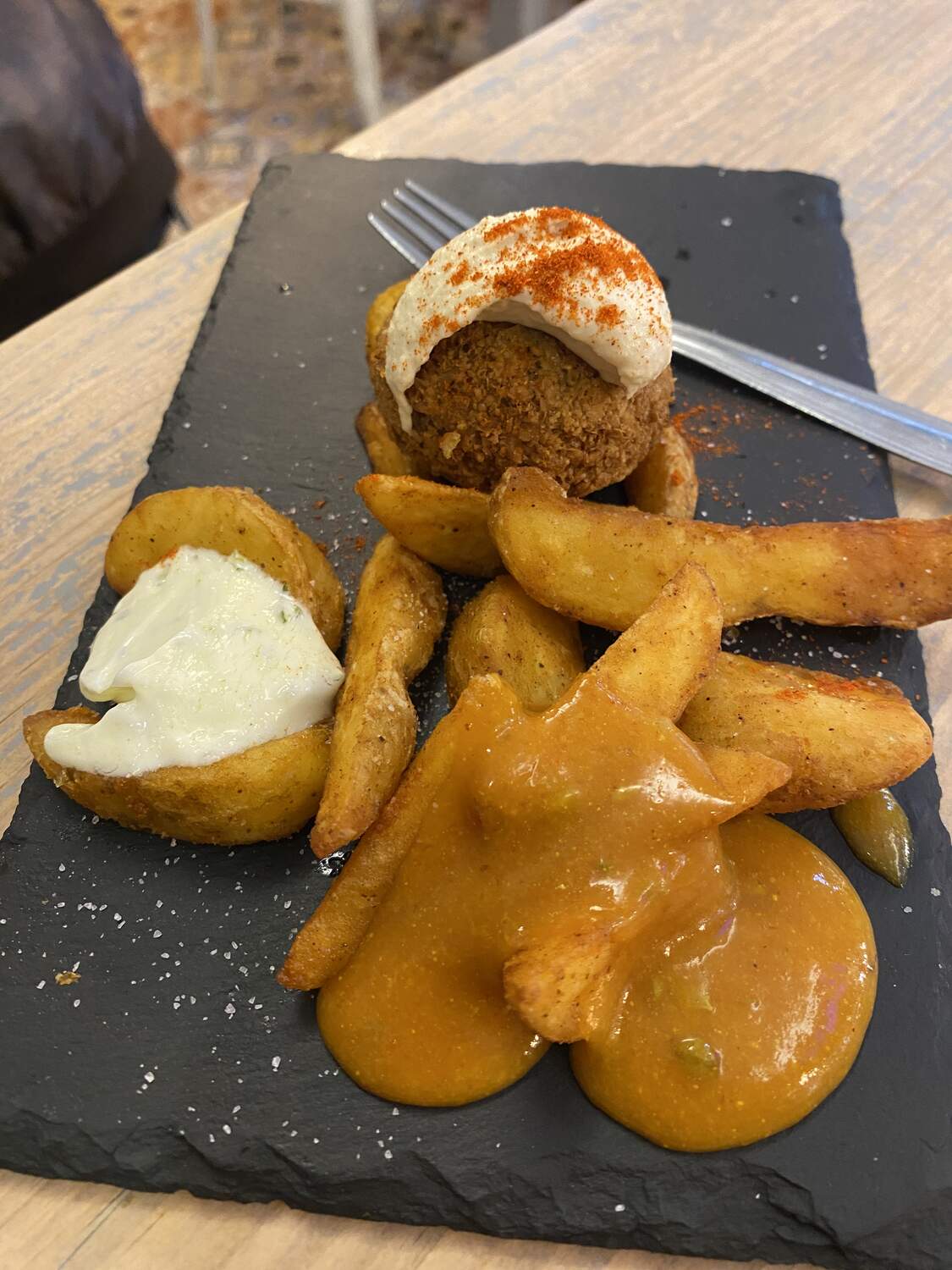
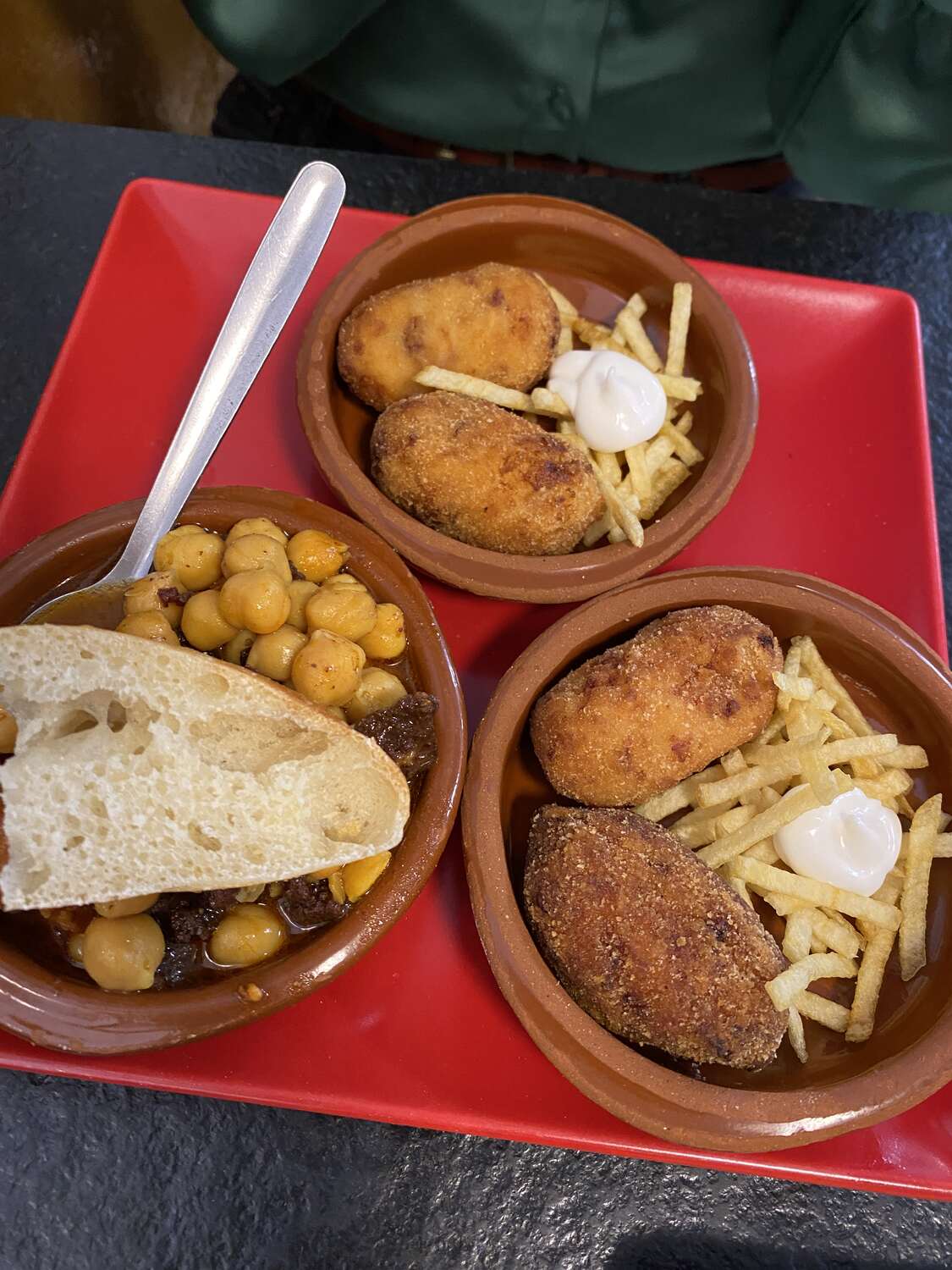
7. Cross the Isabel II Bridge to Triana
Triana sits just across the Guadalquivir River. Cross the Isabel II Bridge (known locally as Puente de Triana), and you’ll get to Triana.
It’s a neighborhood full of character, rich folklore, and craft traditions. To be honest, it’s a relatively quieter area of Seville, less popular with tourist, and I love the setting overall. Spoiler alert: You’ll like it too.
Start with the Triana Market, right by the bridge. You can get cured meats, seafood, and artisanal goods from the local vendors, and you can grab a bite of local treats or some snacks to take home.
Ceramic shops also line the streets. Triana is famous for azulejos (ceramic tilework, which you can also see at Plaza de España). So browse painted tiles or plates, each crafted with ancient techniques that reflect the soul of this region of Spain.
Do yourself a favor and pick one as a keepsake. If you explore further in the area, you’ll find nice little tapas spots, traditional flamenco bars, and a vibe that sets Triana apart from other parts of the city.
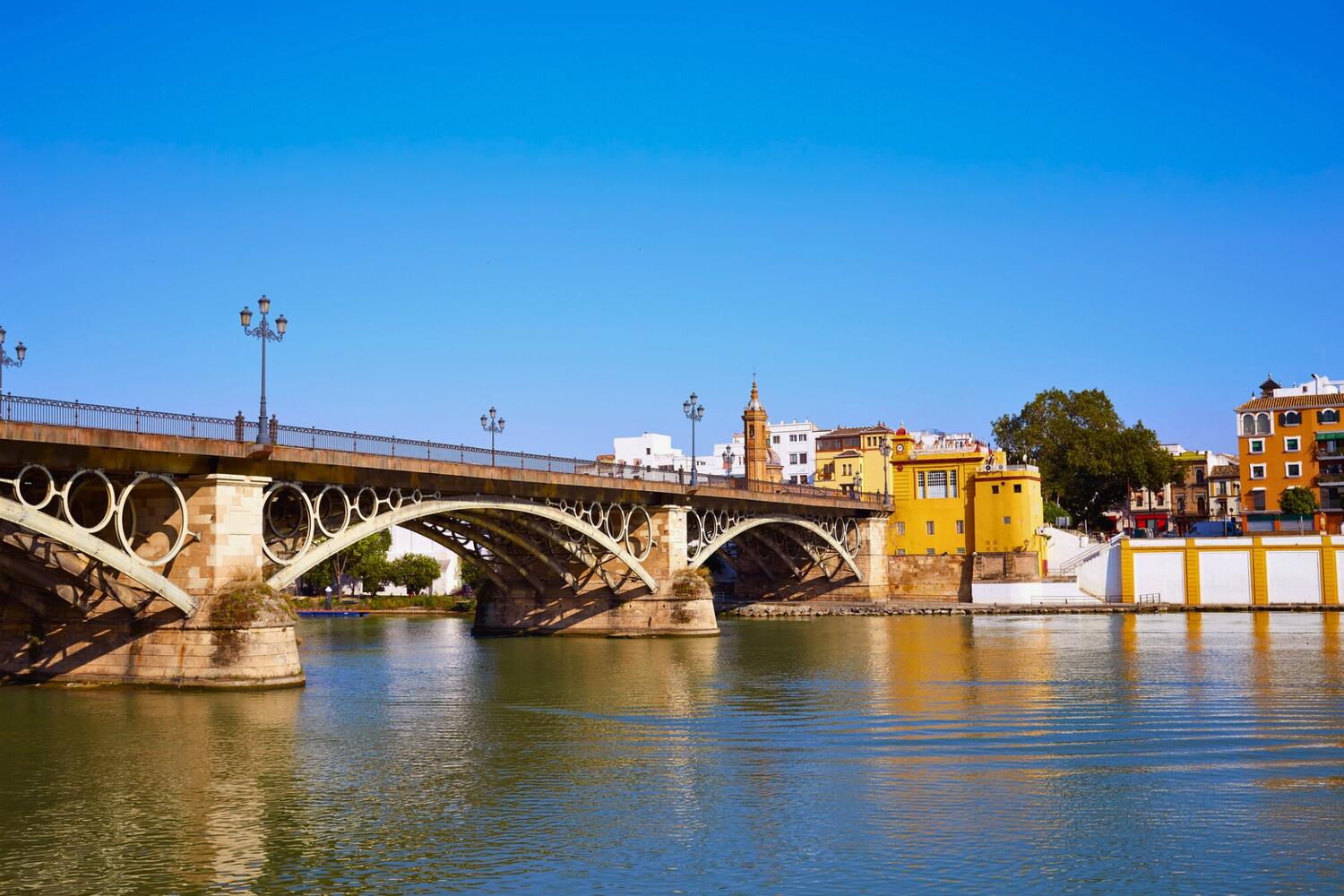
8. Visit the Metropol Parasol (Las Setas de Sevilla)
Las Setas is modern Seville at its boldest. Yes, it’s not the most authentic attraction, but it’s a must-do anyway. Definitely one of the best things to do in Seville.
You’ll see a wooden structure shaped like giant mushrooms, built to revitalize the Plaza de la Encarnación and give a contrast to the city. And they definitely did nail the contrast.
The rooftop walkway is the star attraction. Pay a fee to access panoramic views, where you’ll spot La Giralda, rooftops, and rolling hills on the horizon, all in one spot.
The entrance fee is 15 euros per person. Honestly speaking, this isn’t that cheap by Andalucian standards, but believe me when I say it’s 100% worth it. Also, there’s an audio guide included, so that adds value to the admission fee.
On top of that, check the basement for Roman ruins. An underground museum shows ancient remains discovered during construction, giving you another layer of cultural intrigue before you head back to street level for tapas.
If you can, please go for sunset. The colors stretch across the skyline, making your photos glow and you’ll have a wonderful “Oh wow” moment before you head to a flamenco show or to dinner.
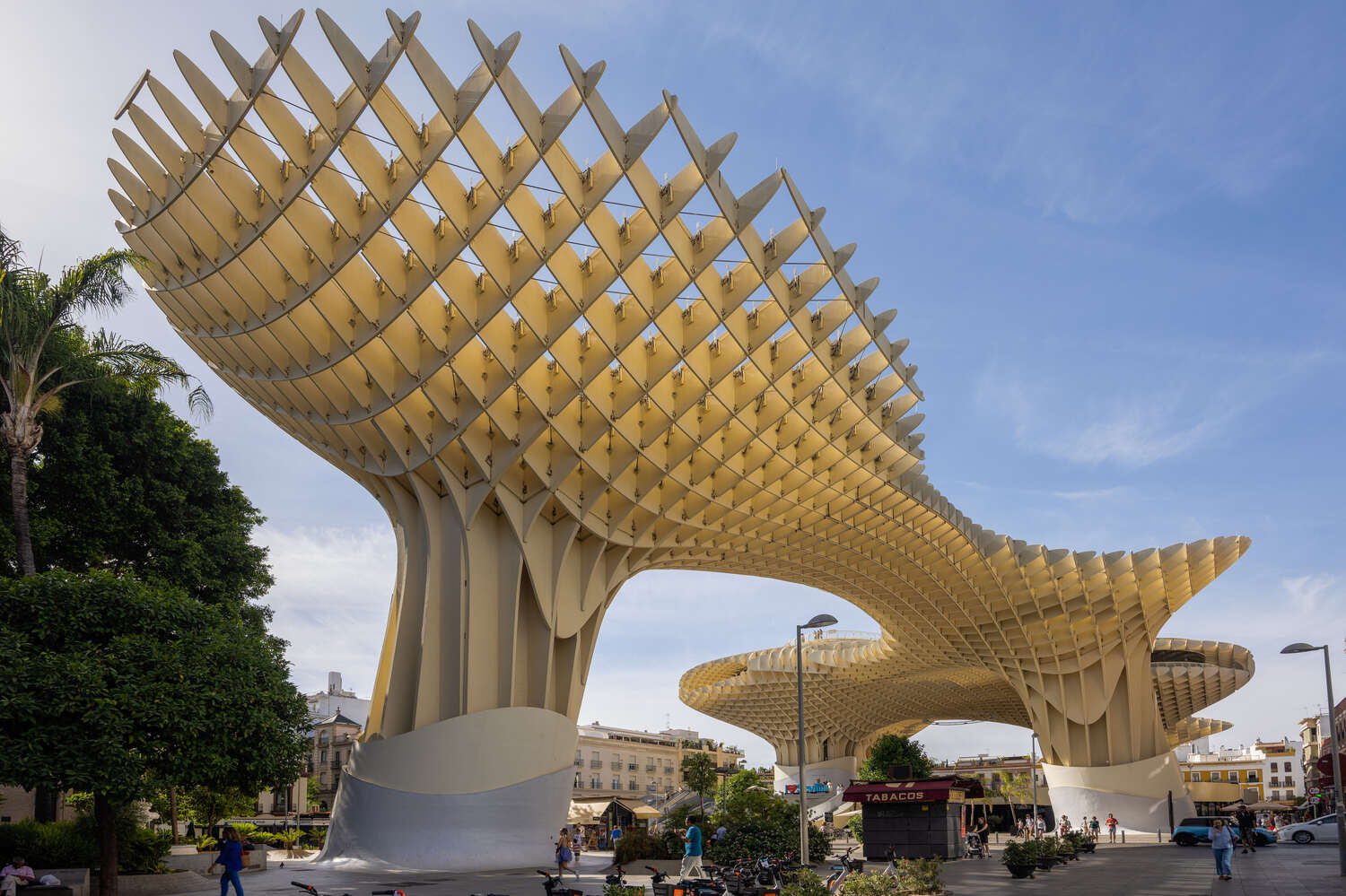
9. Relax at Maria Luisa Park
The best way to describe Maria Luisa Park is with “Seville’s green heart”. It stretches along the Guadalquivir River and it’s right by the Plaza de España. Which means…You can see both at once.
This park was once part of the Palace of San Telmo’s gardens, donated to the city for everyone to enjoy.
There are different pavilions with Moorish touches (those slightly reminded us of the Alhambra in Granada), shady gazebos, and benches perfect for resting for a bit.
Consider renting a bike or horse-drawn carriage to explore around, stopping by statues, tiled fountains, and rose gardens. You can also get one to get from Plaza de España to the park.
Peak bloom is gorgeous in spring. You might also catch local musicians practicing near the water, and that makes the trip even more special!
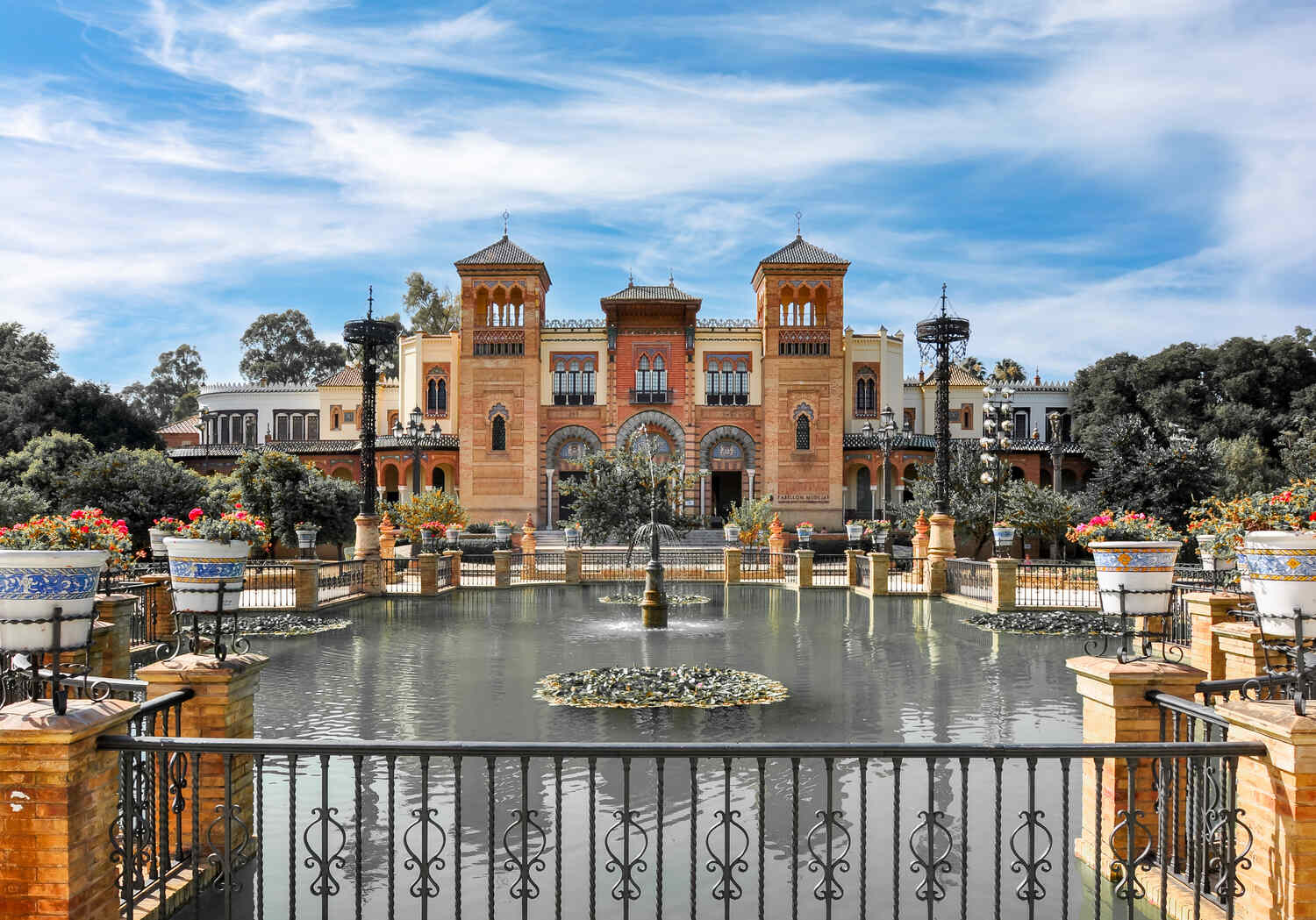
10. Discover the Palace of the Countess of Lebrija
Out of all things to do in Seville, this was probably one of our favorite (truth be told, it’s hard to pick one).
This palace is (I would say) a hidden gem in Seville, and it’s only about 10 minutes’ walk from the Cathedral. There are ancient Roman mosaics rescued from archaeological sites, beautiful Mudéjar ceilings, and a personal art collection from the Countess.
You can tour the ground floor on your own and see the floors and furnishings, but I suggest joining a guided tour to see the upper level’s rooms and treasures. You can’t get upstairs without a guide. Also, you can’t take photos upstairs, but it was unbelievably beautiful.
This Palace was one of the most beautiful we ever visited in the whole of Europe, no doubt about it.
Try to visit in mid-morning when tours are less crowded, so you can explore with a more relaxed pace and see the mosaic-laden courtyard.
You’ll see influences from around the world. That mix of Roman, Arabic, and Renaissance styles is gorgeous, and the best part? It’s well preserved for your modern-day discovery.
The entrance fee is 14 euros per person (6 euros for children) and it’s an excellent place to spend a couple of hours away from the heat.
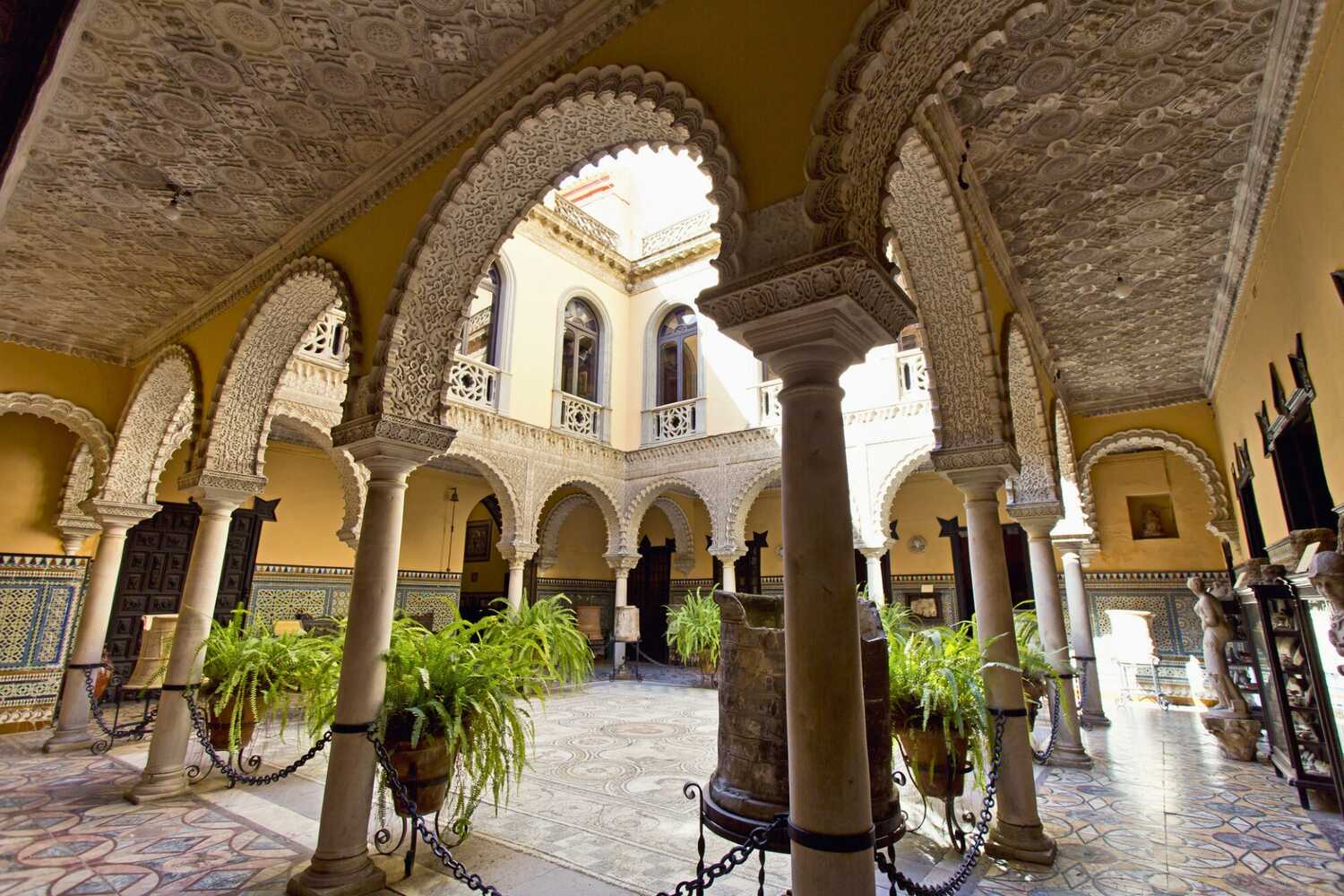
11. Experience Semana Santa and Feria de Abril in Spring
Seville (and southern Spain in general, if I dare say) comes alive in springtime festivities.
Semana Santa, or Holy Week, features solemn processions with elaborate floats, candlelit marches, and music that fills the streets with a spiritual aura.
To be fair, it’s hard to describe the feeling when joining the Semana Santa celebrations. But I’ll try. It’s crowded, it’s chaotic and peaceful at the same time, and it’s…special.
You’ll see lifelike statues of biblical scenes. Right after Easter, the Feria de Abril brings a week of dancing, colorful dresses, horse parades, and lively casetas where you can party until dawn. Yes, Spaniards know how to party, and this is where you’ll see it immediately.
Casetas are private tents, but some are public. Look for those open to everyone, and don’t miss the chance to try rebujito, a mix of sherry and lemon-lime soda that you can find everywhere at this time of the year.
Dress up for Feria if you can. Bright ruffled flamenco dresses and stylish suits are the way to go. What to say, you just can’t miss it if you travel in this period!
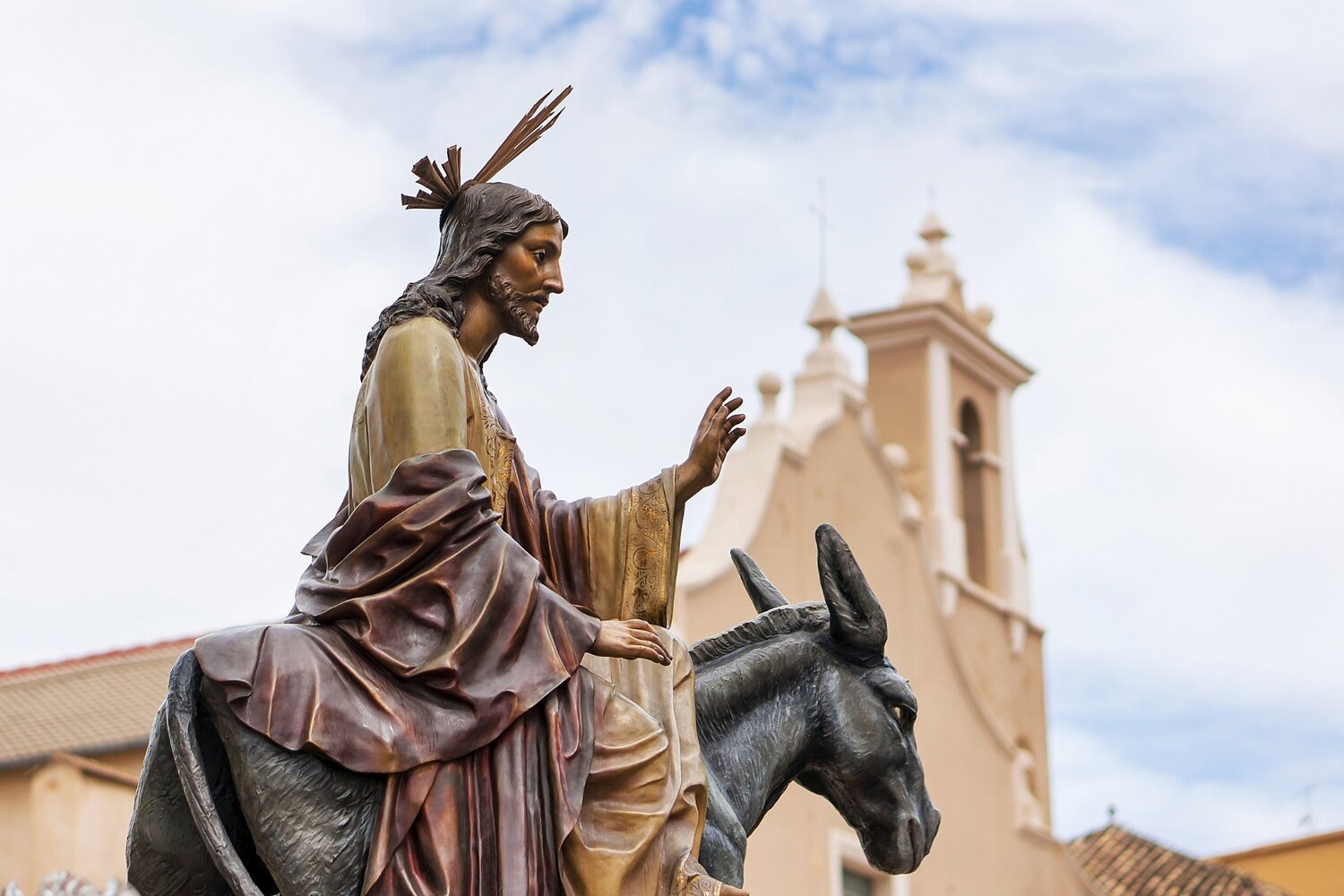
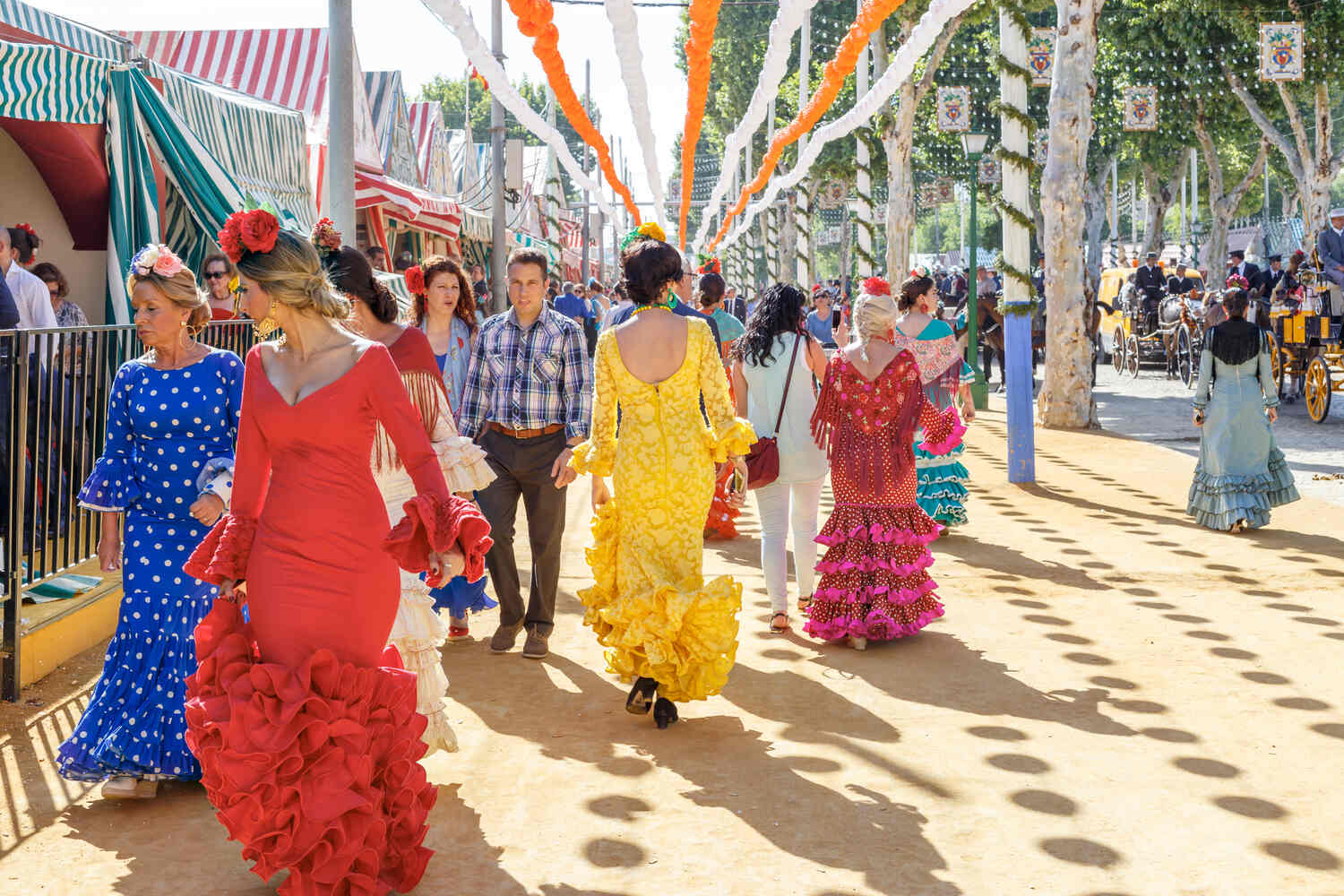
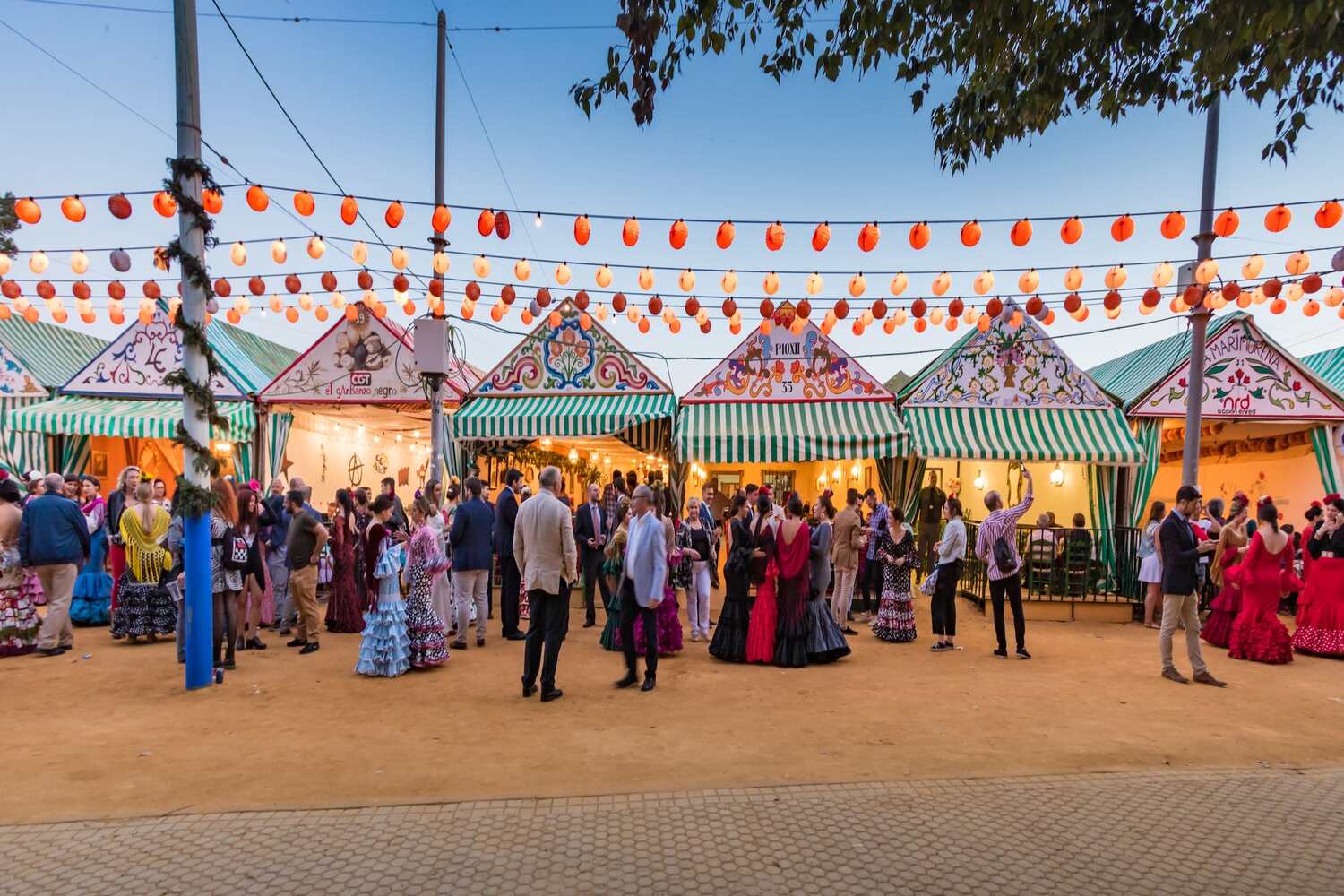
12. Take a Cruise on the Guadalquivir River
The Guadalquivir cuts through the city, and you’ve already passed by if you followed the other things to do in Seville.
A cruise on the river gives you a new look at Seville without all the walking.
Daytime cruises run around €15, and you get to see bridges, old towers, and all sorts of angles that you might miss otherwise.
The water reflects everything around in a way that makes you stop and stare. If you go for a night cruise, things really light up with the city glimmering and the river coming alive at night.
Night trips might cost a bit more if you grab a drink onboard, but it’s worth every cent… and that’s not up for debate.
Lastly, if you travel as a couple, please remember this. There are private, romantic cruises that are perfect for special occasions, like proposing. If that’s your plan, there’s arguably no better place in the city.
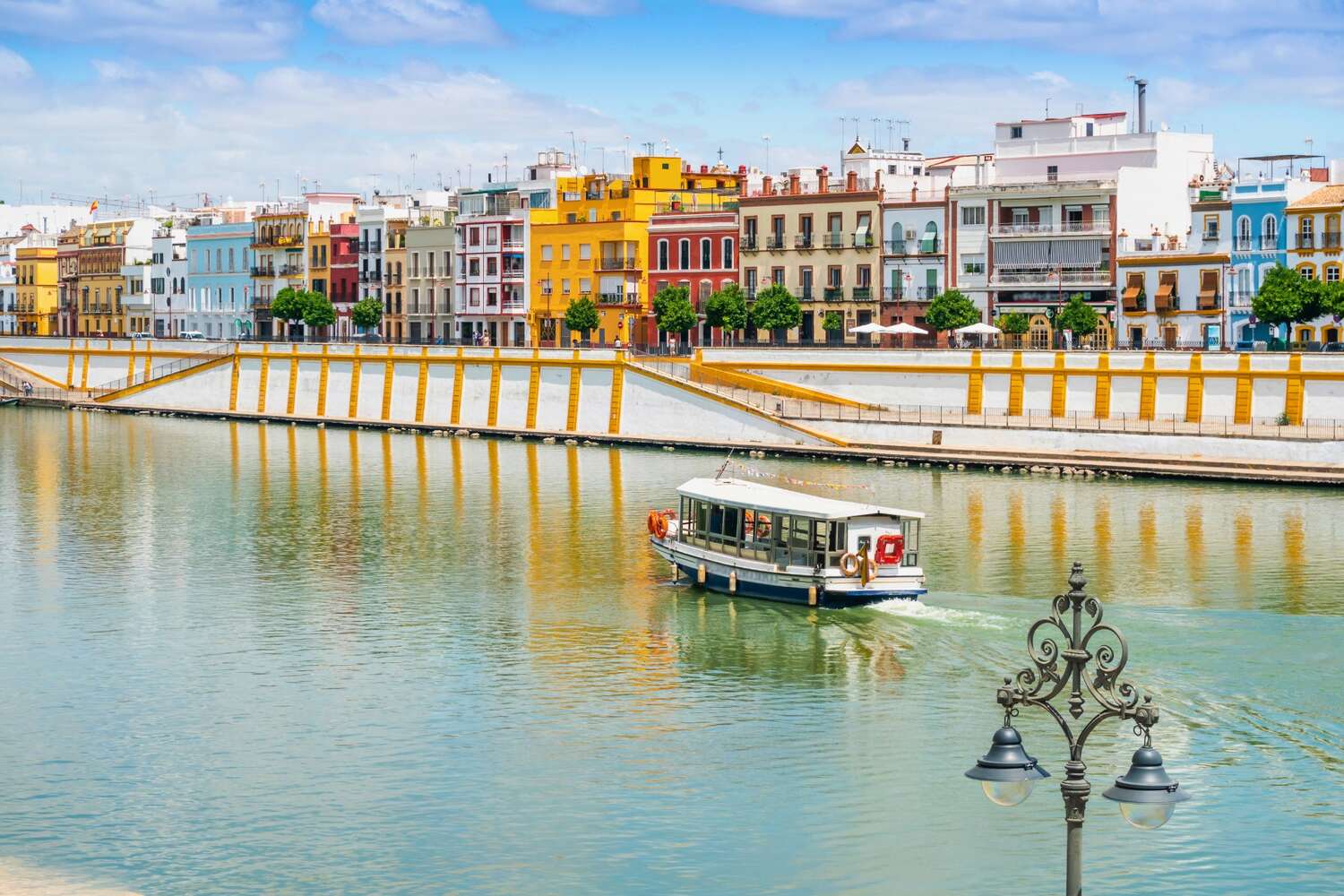
13. Explore the Casa de Pilatos
Casa de Pilatos mixes Moorish with Renaissance looks. Yes, it is the style that you’ll see in the Palace of the Countess of Lebrija, but honestly, both are worth a visit.
It was built in the 1500s, precisely between 1483 and 1571, and it shows off Arabic arches, Italian garden vibes, and Andalusian tiles… All under one roof.
Locals say its owner got ideas from a trip to Jerusalem and even took a nod from Pontius Pilate’s place; Hence the name. You can roam the ground floor and check out the upper rooms loaded with old artwork and antique furniture.
The courtyard is a cool spot for a few snaps with its arched openings and tiled walls. Audio guides break down every little detail, so you can really take it all in.
Also, there were artifacts added to the palace throughout the years, so it’s never really the same year after year. The rooms have been named following the Passion of Christ: Hall of the Praetorian and Chapel of the Flagellations.
Also, note that the Casa de Pilatos is still the permanent residence of the Dukes of Medinaceli, so that adds some interesting part to your visit.
When it comes to the price, the entry fee is 10 euros per person for the first floor only or 12 euros for both floors and an audio guide. Honestly, for 2 euros more, go for the audio guide, and you’ll see even more of the palace.
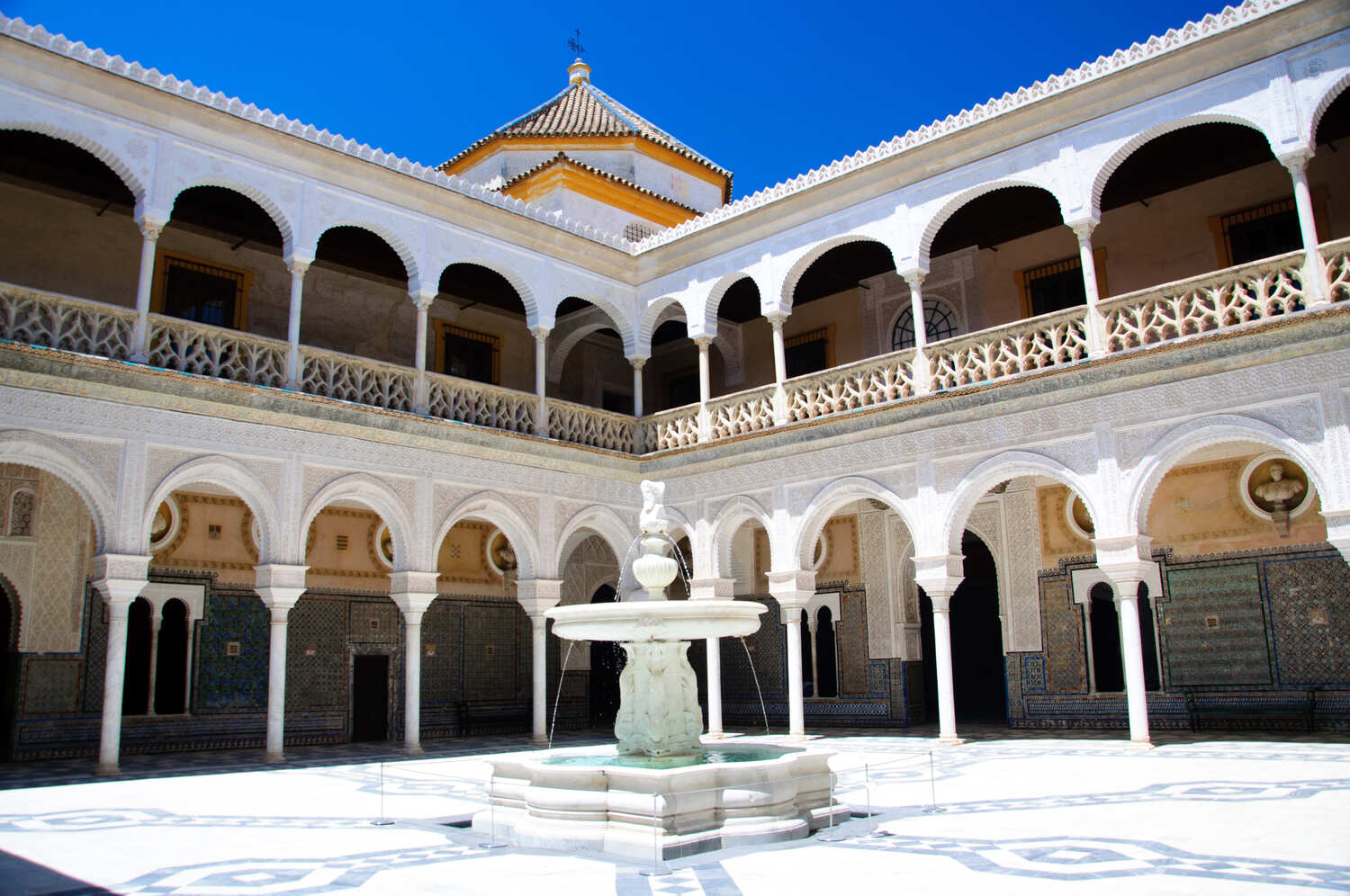
14. Watch the Sunset from Torre del Oro
You’re right, I previously suggested to see the sunset from the Setas de Sevilla. But Torre del Oro, the watchtower by the river, is an amazing alternative.
That’s right, the Torre del Oro gives you a killer sunset view, and I’m not exaggerating. The old tower was originally built to guard the port but it’s now a small naval museum with a rooftop that lights up at dusk.
By the way, if you have enough time on your Seville itinerary, please do visit the museum while you’re at it, it’s really interesting. Entrance is free but a small donation is recommended.
Try to get there just before sundown. The way the water glows and the sky fills with orange and pink really blows you away. Once you’re done up there, stroll along the riverside or hit a tapas joint to savor that afterglow. Don’t forget your camera… no doubt about it.
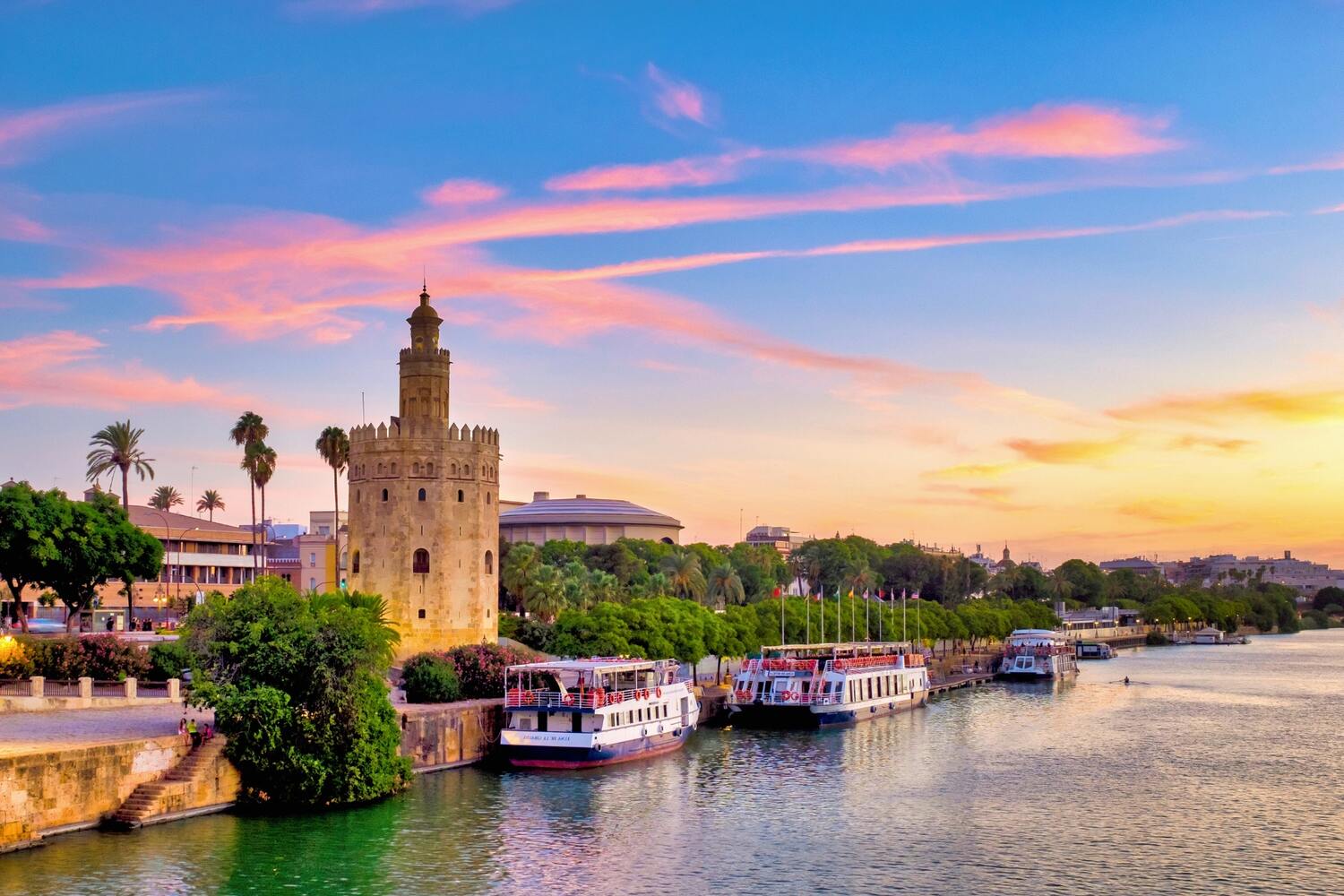
15. Day Trip to Italica
Italica is an old Roman town near Seville, founded back in 206 BC. Italica is where emperors like Trajan and Hadrian were born, and it’s really an incredible thing to do in Seville if you’re into history.
The amphitheater here is one of the biggest in Roman Spain. You can walk in the same corridors where gladiators once got ready for battle. Sure, that isn’t the Colosseum in Rome, but that’s a pretty interesting place nonetheless.
The mosaics still in place show off myth scenes and cool patterns from everyday life. Buses run from Seville, or you can rent a car if you’d rather roam around and check out nearby spots in the Andalusian countryside.
Uber isn’t that expensive in this part of Spain, so you can also grab one to get there, it’ll probably cost you 20 to 30 euros.
Oh, and Game of Thrones was filmed here, so if you’re into it, that’s even nicer to visit I suppose.
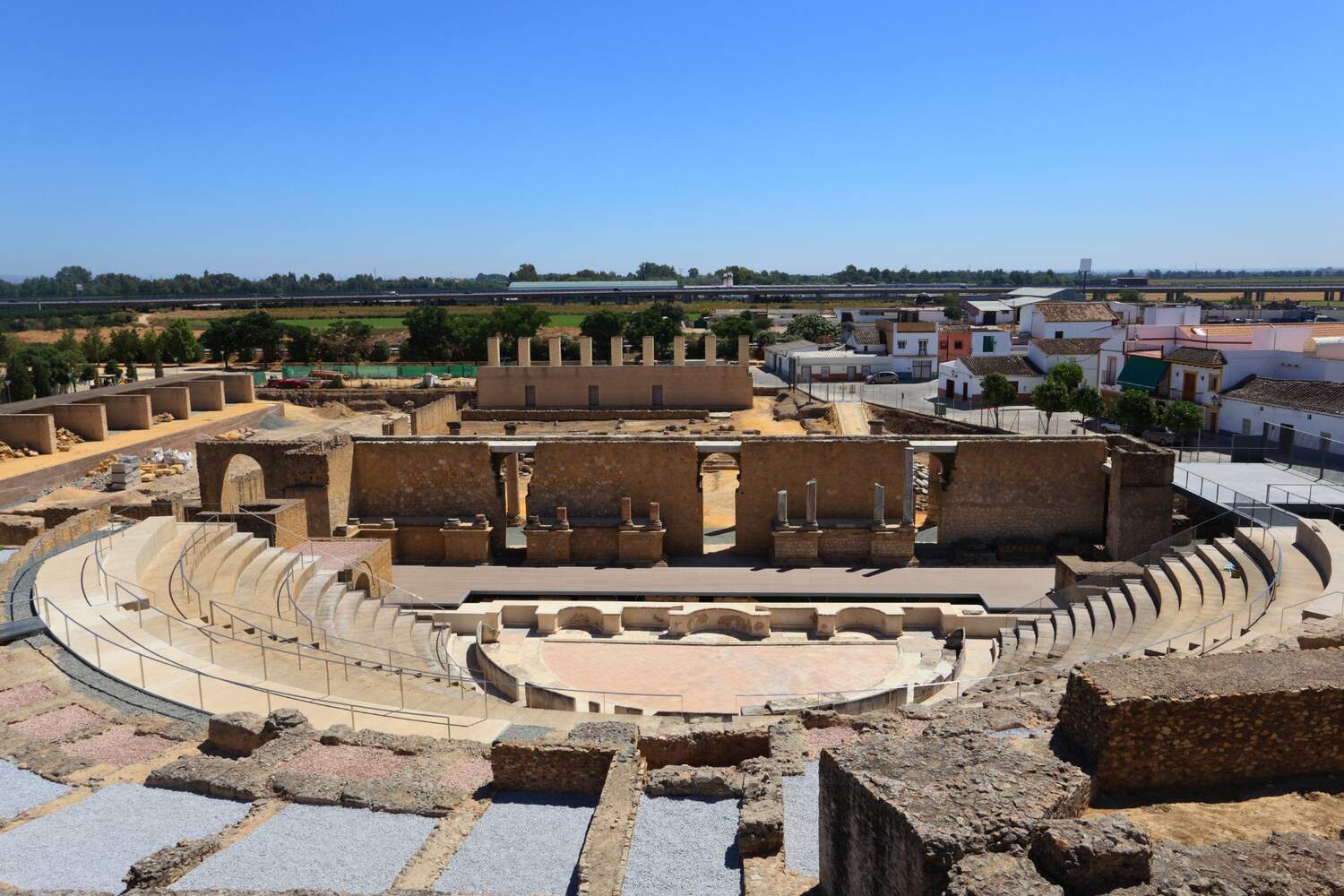
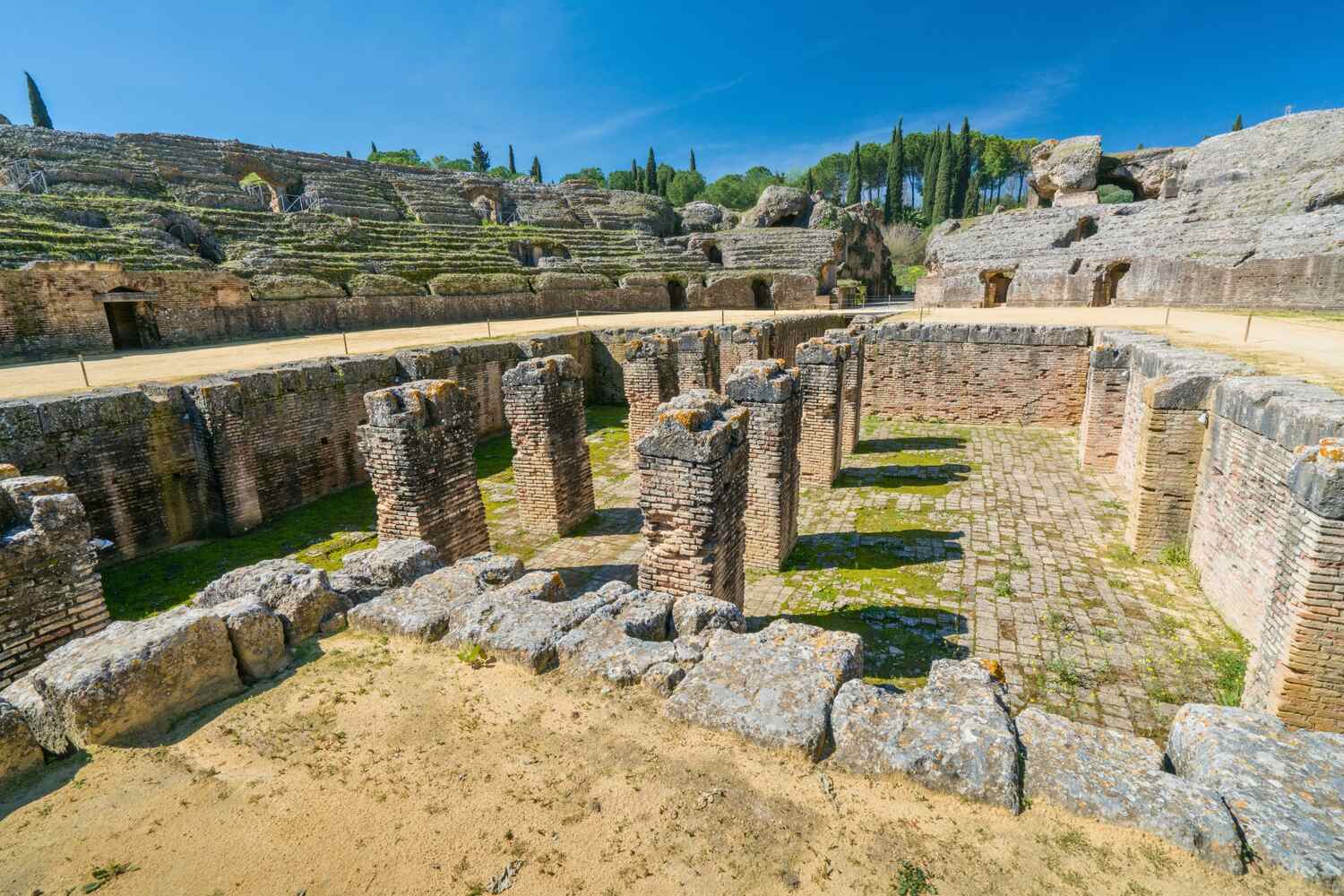
FAQ About Seville
You’ve got questions about Seville, right? Well, here’s a quick FAQ to clear up any confusion, help you plan your trip, and point you toward the best things to do in Seville.
Is Seville Worth Visiting?
Yes, you’ll absolutely love Seville. The city is full of history and there are plenty of delicious dishes to try.
There are ancient palaces to see, lively tapas bars to take a break, and impromptu flamenco shows that are out of this world. You can spend days checking out its corners and soaking in the culture.
The Real Alcázar and the massive cathedral mixed with a buzzing cultural scene makes it hard not to fall for the city, no doubt about it.
What’s the Best Month to Visit Seville?
Seville gets very hot during the summer, so it can get pretty tough when you’re out and about. Spring, though, March, April, May, is spot on with mild weather, blooming flowers everywhere, and nice events like Semana Santa and Feria de Abril.
If you want cooler temperatures without the festival frenzy, try late September through October, which aren’t too crowded either.
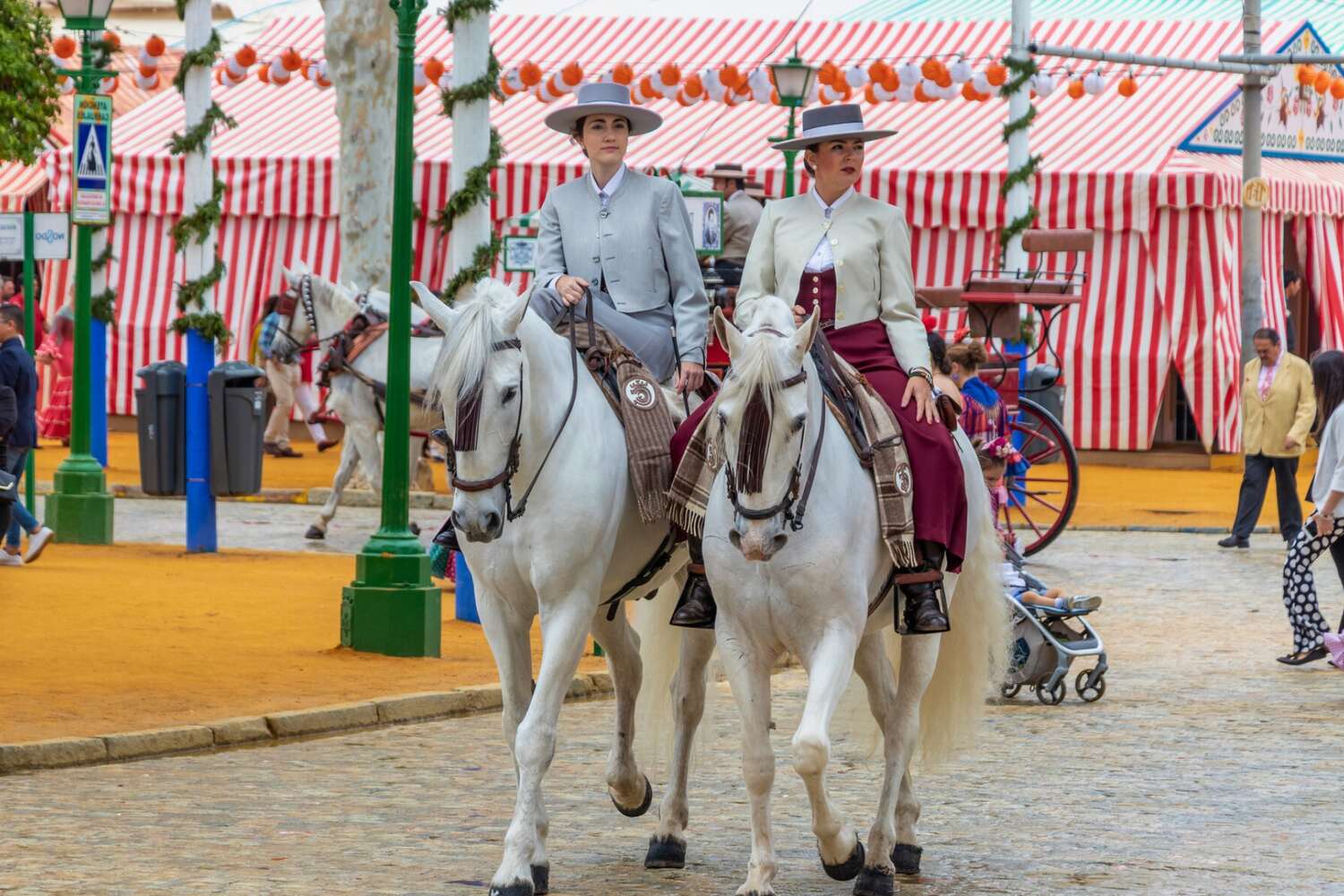
How Many Days to Stay in Seville?
Two to three full days in Seville will set you up nicely to see the Real Alcázar, the Cathedral, and the lively old quarter without feeling rushed.
If you add a day or two, you can check out Triana, relax, and take a quick trip out to places like Italica or Carmona. A longer stay lets you kick back, sip coffee in scenic spots, and really soak up the local life… no argument there.
Is Seville Expensive?
Seville won’t empty your wallet compared to the big cities like Madrid or Barcelona. You can find hostels, mid-range hotels, and even some fancy places if that’s your preference.
Food is quite cheap too. Tapas here will set you back just a few euros each. Sure, some entry fees might add up, but you can get better deals online to save you a bit. Overall, it’s friendly on the budget.
How to Get Around Seville?
Walking is the way to go in Seville since most attractions are quite close to each other. If you like cycling, there’s a rental system called Sevici that’s easy to use. Buses and trams work too if you want to cover more ground.
And if you feel like you need extra freedom, renting a car or calling an Uber is an option.
What to Pack for a Trip to Seville?
Pack light for the warm climate. Think of breathable clothes and comfortable shoes. Even in spring or fall, midday can feel toasty, so throw in a light sweater for the evenings.
Sunscreen and a hat are musts, especially in the summer months, and if you plan on visiting churches or events, pack something modest to cover your shoulders and knees. A daypack for water and little souvenirs is handy too.
Conclusion
Seville is one of those cities that leaves a mark on you. You can see centuries of art and culture, munch on unbelievably good dishes, and catch a live Flamenco show.
Honestly speaking, this is one of the best places to visit in this part of Spain, and I can’t recommend spending some time here. It’s a once-in-a-lifetime trip, and you’ll bring sooo many memories. Enjoy!

